Question 1
Two schools are represented by points `A(2,20)` and `B(14,24)` on the graph below. A road, represented by the line 𝑅 with equation `−x + y = 4`, passes near the schools. An architect is asked to determine the location of a new bus stop on the road such that it is the same distance from the two schools.

(a) Find the equation of the perpendicular bisector of [AB]. Give your equation in the form `y=mx+c`.
(b) Determine the coordinates of the point on `R` where the bus stop should be located.
Mark as Complete
Mark Scheme
Question 2
The Voronoi diagram below shows three identical cellular phone towers, T1, T2 and T3. A fourth cellular phone tower, T4 is located in the shaded region. The dashed lines in the diagram below represent the edges in the Voronoi diagram.
Horizontal scale: 1 unit represents 1 km.
Vertical scale: 1 unit represents 1 km.

Tim stands inside the shaded region.
(a) Explain why Tim will receive the strongest signal from tower T4.
Tower T2 has coordinates `(−9, 5)` and the edge connecting vertices A and B has equation `y = 3`.
(b) Write down the coordinates of tower T4.
Tower T1 has coordinates `(−13, 3)`.
(c) Find the gradient of the edge of the Voronoi diagram between towers T1 and T2.
Mark as Complete
Mark Scheme
Question 3
There are four stations used by the fire wardens in a national forest.
On the following Voronoi diagram, the coordinates of the stations are `A(6,2)`, `B(14, 2)`, `C(18, 6)` and `D(10.8, 11.6)` where distances are measured in kilometres. The dotted lines represent the boundaries of the regions patrolled by the fire warden at each station. The boundaries meet at `P(10, 6)` and `Q(13, 7)`.
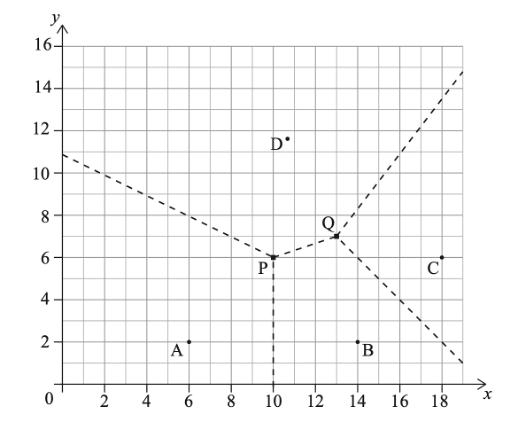
To reduce the areas of the regions that the fire wardens patrol, a new station is to be built within the quadrilateral ABCD. The new station will be located so that it is as far as possible from the nearest existing station.
(a) Show that the new station should be built at P.
The Voronoi diagram is to be updated to include the region around the new station at P. The edges defined by the perpendicular bisectors of [AP] and [BP] have been added to the following diagram.
(b)
(i) Write down the equation of the perpendicular bisector of [PC].
(ii) Hence draw the missing boundaries of the region around P on the following diagram.
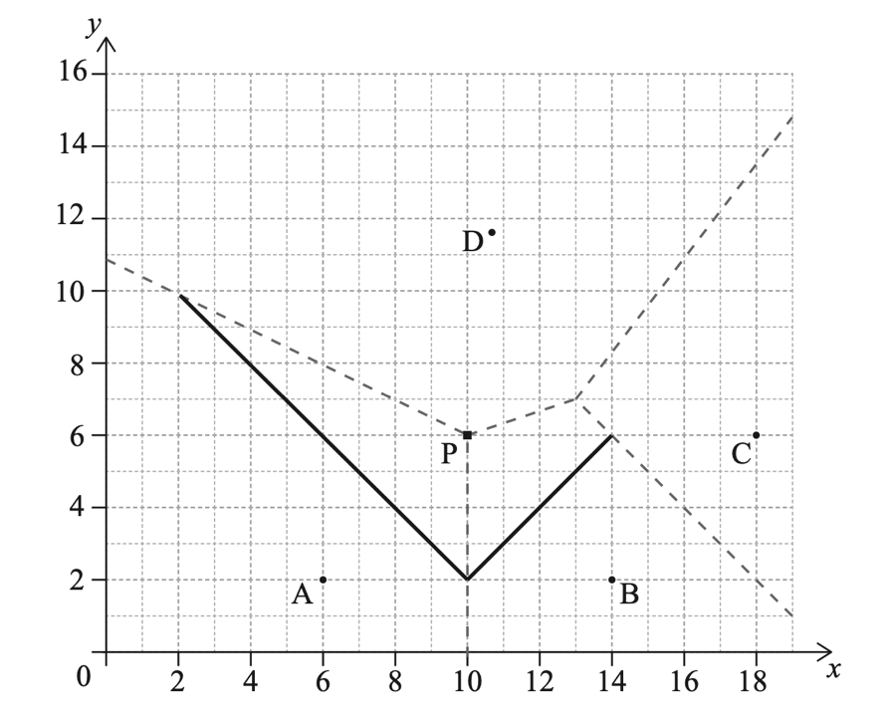
Mark as Complete
Mark Scheme
Question 4
The Voronoi diagram below shows four supermarkets represented by points with coordinates `A(0,0),B(6,0),C(0,6)` and `D(2,2)`. The vertices X, Y, Z are also shown. All distances are measured in kilometres.

(a) Find the midpoint of [BD].
(b) Find the equation of (XZ).
The equation of (XY) is `y = 2 − x` and the equation of (YZ) is `y = 0.5x + 3.5`.
(c) Find the coordinates of X.
The coordinates of Y are `(−1, 3)` and the coordinates of Z are `(7, 7)`.
(d) Determine the exact length of [YZ].
(e) Given that the exact length of [XY] is `sqrt 32`, find the size of `hat{XYZ}` in degrees.
(f) Hence find the area of triangle XYZ.
A town planner believes that the larger the area of the Voronoi cell XYZ, the more people will shop at supermarket D.
(g) State one criticism of this interpretation.
Mark as Complete
Mark Scheme
Question 5
Three towns, A, B and C are represented as coordinates on a map, where the `x` and `y` axes represent the distances east and north of an origin, respectively, measured in kilometres.
Town A is located at `(−6, −1)` and town B is located at `(8, 6)`. A road runs along the perpendicular bisector of [AB]. This information is shown in the following diagram.
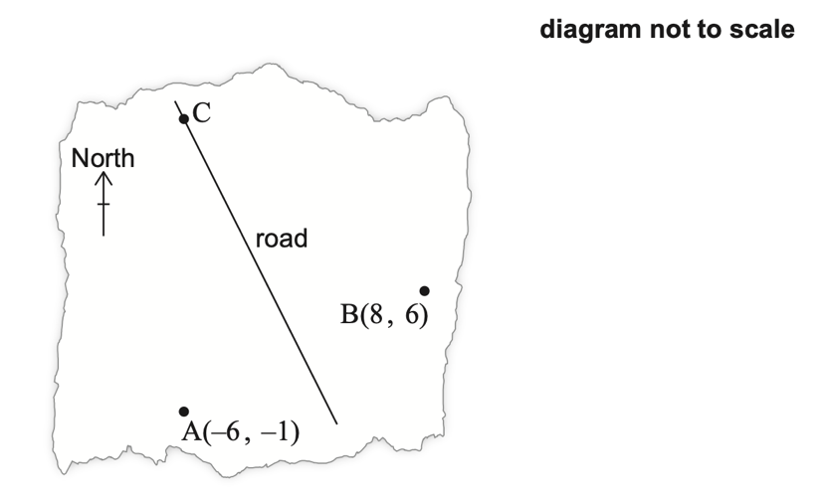
(a) Find the equation of the line that the road follows.
Town C is due north of town A and the road passes through town C.
(b) Find the `y`-coordinate of town C.
Mark as Complete
Mark Scheme
Question 6
Six restaurant locations (labelled A, B, C, D, E and F) are shown, together with their Voronoi diagram. All distances are measured in kilometres.
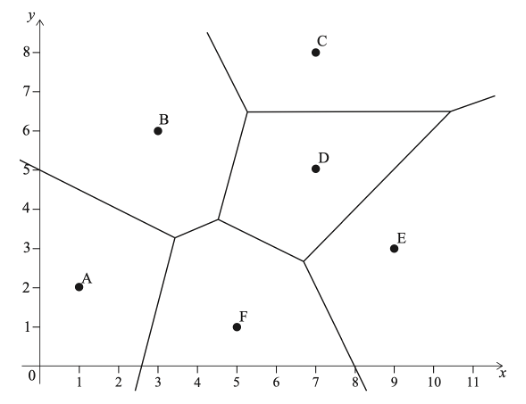
(a) Elena wants to eat at the closest restaurant to her. Write down the restaurant she should go to, if she is at
(i) (2, 7).
(ii) (0, 1), when restaurant A is closed.
Restaurant C is at (7, 8) and restaurant D is at (7, 5).
(b) Find the equation of the perpendicular bisector of CD.
Restaurant B is at (3, 6).
(c) Find the equation of the perpendicular bisector of BC.
(d) Hence find
(i) the coordinates of the point which is of equal distance from B, C and D.
(ii) the distance of this point from D.
Mark as Complete
Mark Scheme
Question 7
Ani owns four cafes represented by points A, B, C and D. Ani wants to divide the area into delivery regions. This process has been started in the following incomplete Voronoi diagram, where 1 unit represents 1 kilometre.
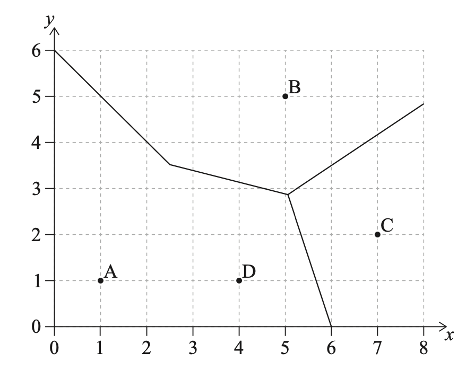
The midpoint of CD is `(5.5, 1.5)`.
(a) Show that the equation of the perpendicular bisector of [CD] is `y = −3x + 18`.
(b) Complete the Voronoi diagram shown above.
Ani opens an office equidistant from three of the cafes, B, C and D. The equation of the perpendicular bisector of [BC] is `3y = 2x − 1.5`.
(c) Find the coordinates of the office.
Mark as Complete
Mark Scheme
Question 8
On the following Voronoi diagram, the coordinates of three farmhouses are `A(0, 3), B(8, 3)` and `C(8, 13)`, where distances are measured in kilometres. Each farmhouse owns the land that is closest to it, and their boundaries are defined by the dotted lines on Diagram 1.
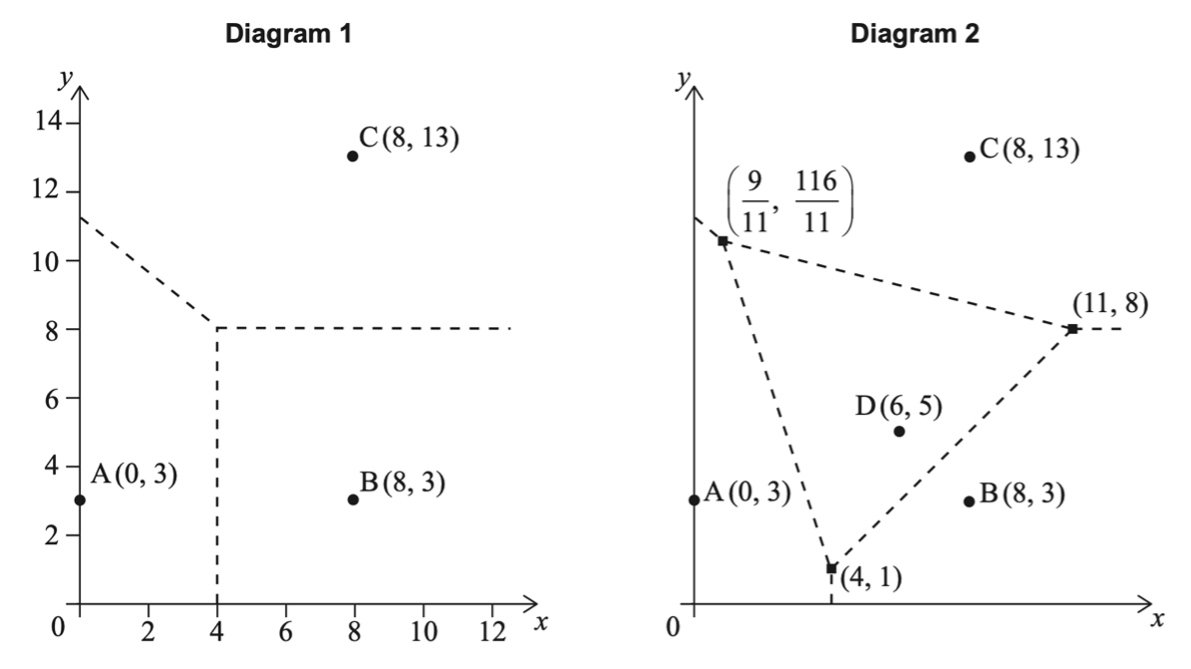
To provide water to the farms it is decided to construct a well at the point where the boundaries meet on Diagram 1.
(a) Write down the coordinates of this point.
(b) Find the equation of the perpendicular bisector of [AC].
An additional farmhouse `D(6, 5)` is built on the land. The Voronoi diagram has been redrawn to show the new boundaries. The coordinates of the vertices of these boundaries are indicated on Diagram 2.
A wind turbine is to be built at one of the vertices.
(c) The wind turbine should be as far from the nearest farmhouses as possible.
(i) By calculating appropriate distances, find the location of the wind turbine.
(ii) Hence, write down the distance of the wind turbine to the nearest farmhouse.
Mark as Complete
Mark Scheme
Question 9
Points `A (3, 4), B (9, 6)` and `C (11, 2)` are shown on the following diagram, along with the perpendicular bisectors of [AB], [AC] and [BC].

The perpendicular bisector of [BC] intercepts the axes at coordinates (0, −1) and (2, 0).
(a) Write down the equation of the perpendicular bisector of [BC].
The equation of the perpendicular bisector of [AB] is `y = −3x + 23`.
(b) Find the coordinates of point V where the perpendicular bisectors meet. Give your answer to four significant figures.
A Voronoi diagram is constructed with points A, B and C as the three sites.
(c) Draw, clearly, the edges of the Voronoi diagram on the given diagram.
Mark as Complete
Mark Scheme
Question 10
Mai is at an amusement park. A map of part of the amusement park is represented on the following coordinate axes.
Mai’s favourite three attractions are positioned at `A(0, 16), B(12, 20)` and `C(12, 0)`. All measurements are in metres.
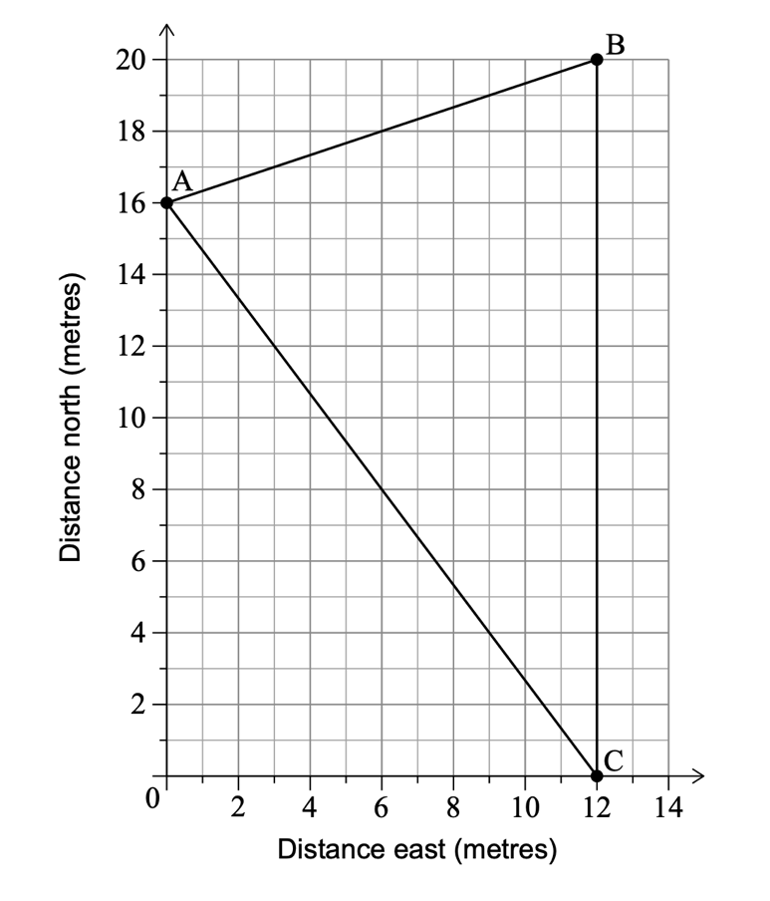
(a) Write down the distance between B and C.
(b) Calculate the distance between A and B.
Mai is standing at the attraction at B and wants to walk directly to the attraction at A.
(c) Calculate the bearing of A from B.
(d)
(i) Write down the gradient of [AC].
(ii) Write down the mid-point of [AC].
(iii) Hence calculate the coordinates of the drinking fountain.
Mark as Complete
Mark Scheme
Question 1
Two schools are represented by points `A(2,20)` and `B(14,24)` on the graph below. A road, represented by the line 𝑅 with equation `−x + y = 4`, passes near the schools. An architect is asked to determine the location of a new bus stop on the road such that it is the same distance from the two schools.

(a) Find the equation of the perpendicular bisector of [AB]. Give your equation in the form `y=mx+c`.
(b) Determine the coordinates of the point on `R` where the bus stop should be located.
(a) gradient AB `=4/12 \ (1/3)`
midpoint AB: `(8,22)`
gradient of bisector `=-1/{gr adient \ AB} =-3`
perpendicular bisector: `(y-22)=-3(x-8)`
perpendicular bisector: `y=-3x+46`
(b) attempt to solve simultaneous equations
`x+4=-3x+46`
`(10.5, 14.5)`
Question 2
The Voronoi diagram below shows three identical cellular phone towers, T1, T2 and T3. A fourth cellular phone tower, T4 is located in the shaded region. The dashed lines in the diagram below represent the edges in the Voronoi diagram.
Horizontal scale: 1 unit represents 1 km.
Vertical scale: 1 unit represents 1 km.

Tim stands inside the shaded region.
(a) Explain why Tim will receive the strongest signal from tower T4.
Tower T2 has coordinates `(−9, 5)` and the edge connecting vertices A and B has equation `y = 3`.
(b) Write down the coordinates of tower T4.
Tower T1 has coordinates `(−13, 3)`.
(c) Find the gradient of the edge of the Voronoi diagram between towers T1 and T2.
(a) every point in the shaded region is closer to tower T4
(b) `(−9, 1)`
(c) correct use of gradient formula
e.g. `(m=) {5-3}/{-9-(-13)} \ (=1/2)`
taking negative reciprocal of their `m` (at any point)
edge gradient `= −2`
Question 3
There are four stations used by the fire wardens in a national forest.
On the following Voronoi diagram, the coordinates of the stations are `A(6,2)`, `B(14, 2)`, `C(18, 6)` and `D(10.8, 11.6)` where distances are measured in kilometres. The dotted lines represent the boundaries of the regions patrolled by the fire warden at each station. The boundaries meet at `P(10, 6)` and `Q(13, 7)`.

To reduce the areas of the regions that the fire wardens patrol, a new station is to be built within the quadrilateral ABCD. The new station will be located so that it is as far as possible from the nearest existing station.
(a) Show that the new station should be built at P.
The Voronoi diagram is to be updated to include the region around the new station at P. The edges defined by the perpendicular bisectors of [AP] and [BP] have been added to the following diagram.
(b)
(i) Write down the equation of the perpendicular bisector of [PC].
(ii) Hence draw the missing boundaries of the region around P on the following diagram.

(a) (the best placement is either point P or point Q)
attempt at using the distance formula
`AP=sqrt{(10-6)^2+(6-2)^2}` OR
`BQ=sqrt{(13-14)^2+(7-2)^2}`
(AP or BP or DP `=`) `sqrt 32 = 5.66 (5.65685 ... )` AND
(BQ or CQ or DQ `=`) `sqrt 26 = 5.10 (5.09901 ... )`
AP (or BP or DP) is greater than BQ (or CQ or DQ)
point P is the furthest away
(b)
(i) `x=14`
(ii)
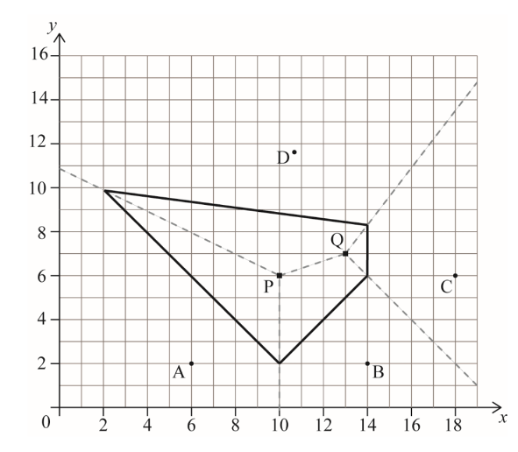
Question 4
The Voronoi diagram below shows four supermarkets represented by points with coordinates `A(0,0),B(6,0),C(0,6)` and `D(2,2)`. The vertices X, Y, Z are also shown. All distances are measured in kilometres.

(a) Find the midpoint of [BD].
(b) Find the equation of (XZ).
The equation of (XY) is `y = 2 − x` and the equation of (YZ) is `y = 0.5x + 3.5`.
(c) Find the coordinates of X.
The coordinates of Y are `(−1, 3)` and the coordinates of Z are `(7, 7)`.
(d) Determine the exact length of [YZ].
(e) Given that the exact length of [XY] is `sqrt 32`, find the size of `hat{XYZ}` in degrees.
(f) Hence find the area of triangle XYZ.
A town planner believes that the larger the area of the Voronoi cell XYZ, the more people will shop at supermarket D.
(g) State one criticism of this interpretation.
(a) `({2+6}/2,{2+0}/2)`
`(4,1)`
(b) attempt to substitute values into gradient formula
`({0-2}/{6-2}=) \ -1/2`
therefore the gradient of perpendicular bisector is 2
so `y-1=2(x-4) \ \ \ \ \ (y=2x-7)`
(c) identifying the correct equations to use:
`y=2-x` and `y=2x-7`
evidence of solving their correct equations or of finding intersection point graphically
`(3, −1)`
(d) attempt to use distance formula
`YZ=sqrt{(7-(-1))^2+(7-3)^2}=sqrt 80 \ \ \ (4\sqrt 5)`
(e) length of XZ is `sqrt 80 \ \ \ (4sqrt5, 8.94427 ...)`
required angle is `cos^-1 (sqrt 32/{2sqrt80})`
`( hat{XYZ}=) 71.6^@ \ \ \ (71.5650^@)`
(f) (area `=`) `1/2 sqrt 32 sqrt 72 = 24 \ km^2`
(g) Any sensible answer such as:
Question 5
Three towns, A, B and C are represented as coordinates on a map, where the `x` and `y` axes represent the distances east and north of an origin, respectively, measured in kilometres.
Town A is located at `(−6, −1)` and town B is located at `(8, 6)`. A road runs along the perpendicular bisector of [AB]. This information is shown in the following diagram.

(a) Find the equation of the line that the road follows.
Town C is due north of town A and the road passes through town C.
(b) Find the `y`-coordinate of town C.
(a) midpoint `(1, 2.5)`
`m_{AB}={6-(-1)}/{8-(-6)}=1/2`
`m_bot = -2`
`y=-2x+9/2`
(b) substituting `x = −6` into their equation from part (a)
`y=-2(-6)+9/2`
`y = 16.5`
Question 6
Six restaurant locations (labelled A, B, C, D, E and F) are shown, together with their Voronoi diagram. All distances are measured in kilometres.

(a) Elena wants to eat at the closest restaurant to her. Write down the restaurant she should go to, if she is at
(i) (2, 7).
(ii) (0, 1), when restaurant A is closed.
Restaurant C is at (7, 8) and restaurant D is at (7, 5).
(b) Find the equation of the perpendicular bisector of CD.
Restaurant B is at (3, 6).
(c) Find the equation of the perpendicular bisector of BC.
(d) Hence find
(i) the coordinates of the point which is of equal distance from B, C and D.
(ii) the distance of this point from D.
(a)
(i) B
(ii) F
(b) correct substitution into the midpoint formula
`{8+5}/2`
`y=6.5`
(c) midpoint `= (5, 7)`
correct use of gradient formula
`{8-6}/{7-3}`
gradient of BC `= 0.5`
negative reciprocal of gradient
perpendicular gradient `= −2`
`y − 7 = −2(x − 5)` (or `y = −2x + 17`)
(d)
(i)
attempt to find the intersection of two perpendicular bisectors (BC & CD)
`6.5 = −2x + 17`
`(5.25, 6.5)`
(ii)
their correct substitution into distance formula
`sqrt{(5.25-7)^2+(6.5-5)^2}=2.30 \ km \ (2.30488 ..., \sqrt 85 /4)`
Question 7
Ani owns four cafes represented by points A, B, C and D. Ani wants to divide the area into delivery regions. This process has been started in the following incomplete Voronoi diagram, where 1 unit represents 1 kilometre.

The midpoint of CD is `(5.5, 1.5)`.
(a) Show that the equation of the perpendicular bisector of [CD] is `y = −3x + 18`.
(b) Complete the Voronoi diagram shown above.
Ani opens an office equidistant from three of the cafes, B, C and D. The equation of the perpendicular bisector of [BC] is `3y = 2x − 1.5`.
(c) Find the coordinates of the office.
(a) attempt to find gradient of CD
gradient of CD `=1/3` therefore perpendicular gradient CD `=-3`
`y − 1.5 = −3(x − 5.5)`
`y = −3x + 18`
(b)

perpendicular bisector AD: a vertical line with `x` intercept 2.5
(c) attempt to solve simultaneous equations: `3y = 2x − 1.5` and `y = −3x + 18`
`(5.05, 2.86)\ \ \ \ \ \( \ (5.04545 ...,2.86363 ... )\ )`
Question 8
On the following Voronoi diagram, the coordinates of three farmhouses are `A(0, 3), B(8, 3)` and `C(8, 13)`, where distances are measured in kilometres. Each farmhouse owns the land that is closest to it, and their boundaries are defined by the dotted lines on Diagram 1.

To provide water to the farms it is decided to construct a well at the point where the boundaries meet on Diagram 1.
(a) Write down the coordinates of this point.
(b) Find the equation of the perpendicular bisector of [AC].
An additional farmhouse `D(6, 5)` is built on the land. The Voronoi diagram has been redrawn to show the new boundaries. The coordinates of the vertices of these boundaries are indicated on Diagram 2.
A wind turbine is to be built at one of the vertices.
(c) The wind turbine should be as far from the nearest farmhouses as possible.
(i) By calculating appropriate distances, find the location of the wind turbine.
(ii) Hence, write down the distance of the wind turbine to the nearest farmhouse.
(a) `(4,8)`
(b) attempt to find the gradient of AC
`(13-3)/(8-0), 10/8, (5/4), (1.25)`
attempt to substitute their coordinates and the negative reciprocal of their gradient into the equation of a straight line
`y-8=-4/5 (x-4)`
`(y = −0.8x + 11.2, 4x + 5y − 56 = 0)`
(c)
(i) attempt to find one distance from a farm to any closest vertex
finding a correct distance from at least two distinct vertices
`7.58968 ... , 4.472135 ... (sqrt 20), 5.830951 ... (sqrt 34)`
`(9/11,116/11)` (is furthest)
(ii) 7.59 (km) (`=` 7.58968...)
Question 9
Points `A (3, 4), B (9, 6)` and `C (11, 2)` are shown on the following diagram, along with the perpendicular bisectors of [AB], [AC] and [BC].

The perpendicular bisector of [BC] intercepts the axes at coordinates (0, −1) and (2, 0).
(a) Write down the equation of the perpendicular bisector of [BC].
The equation of the perpendicular bisector of [AB] is `y = −3x + 23`.
(b) Find the coordinates of point V where the perpendicular bisectors meet. Give your answer to four significant figures.
A Voronoi diagram is constructed with points A, B and C as the three sites.
(c) Draw, clearly, the edges of the Voronoi diagram on the given diagram.
(a) `y=0.5x−1`
(b) `(6.857, 2.429)`
(c)

Question 10
Mai is at an amusement park. A map of part of the amusement park is represented on the following coordinate axes.
Mai’s favourite three attractions are positioned at `A(0, 16), B(12, 20)` and `C(12, 0)`. All measurements are in metres.

(a) Write down the distance between B and C.
(b) Calculate the distance between A and B.
Mai is standing at the attraction at B and wants to walk directly to the attraction at A.
(c) Calculate the bearing of A from B.
(d)
(i) Write down the gradient of [AC].
(ii) Write down the mid-point of [AC].
(iii) Hence calculate the coordinates of the drinking fountain.
(a) BC = 20 (m)
(b) use of Pythagoras
`AB = sqrt(12^2+4^2) = 12.6 \ (m) \ (12.6491 ... , sqrt 160)`
(c) finding angle that AB makes with the horizontal (angle `H`)
correct use of a trig ratio to find `H`, the angle AB makes with horizontal
e.g. `tan hat H=4/12, cos hat H= (12^2+12.649^2-4^2)/(2 times 12 times 12.649)`
`hat H = 18.4 \ (18.4349 ...)`
`270−18.4348...=252^@ (251.565...)`
(d)
(i) `-4/3 \ \ \ (-16/12)`
(ii) `(6,8)`
(iii) gradient of (their) perp line `=3/4`
equation of perpendicular bisector of AC
e.g. `(y-8)=3/4 (x-6)`
equation of perpendicular bisector of BC is `y=10`
point of intersection `(8 2/3 , 10)`
Question 1
Two schools are represented by points `A(2,20)` and `B(14,24)` on the graph below. A road, represented by the line 𝑅 with equation `−x + y = 4`, passes near the schools. An architect is asked to determine the location of a new bus stop on the road such that it is the same distance from the two schools.

(a) Find the equation of the perpendicular bisector of [AB]. Give your equation in the form `y=mx+c`.
(b) Determine the coordinates of the point on `R` where the bus stop should be located.
Question 2
The Voronoi diagram below shows three identical cellular phone towers, T1, T2 and T3. A fourth cellular phone tower, T4 is located in the shaded region. The dashed lines in the diagram below represent the edges in the Voronoi diagram.
Horizontal scale: 1 unit represents 1 km.
Vertical scale: 1 unit represents 1 km.

Tim stands inside the shaded region.
(a) Explain why Tim will receive the strongest signal from tower T4.
Tower T2 has coordinates `(−9, 5)` and the edge connecting vertices A and B has equation `y = 3`.
(b) Write down the coordinates of tower T4.
Tower T1 has coordinates `(−13, 3)`.
(c) Find the gradient of the edge of the Voronoi diagram between towers T1 and T2.
Question 3
There are four stations used by the fire wardens in a national forest.
On the following Voronoi diagram, the coordinates of the stations are `A(6,2)`, `B(14, 2)`, `C(18, 6)` and `D(10.8, 11.6)` where distances are measured in kilometres. The dotted lines represent the boundaries of the regions patrolled by the fire warden at each station. The boundaries meet at `P(10, 6)` and `Q(13, 7)`.

To reduce the areas of the regions that the fire wardens patrol, a new station is to be built within the quadrilateral ABCD. The new station will be located so that it is as far as possible from the nearest existing station.
(a) Show that the new station should be built at P.
The Voronoi diagram is to be updated to include the region around the new station at P. The edges defined by the perpendicular bisectors of [AP] and [BP] have been added to the following diagram.
(b)
(i) Write down the equation of the perpendicular bisector of [PC].
(ii) Hence draw the missing boundaries of the region around P on the following diagram.

Question 4
The Voronoi diagram below shows four supermarkets represented by points with coordinates `A(0,0),B(6,0),C(0,6)` and `D(2,2)`. The vertices X, Y, Z are also shown. All distances are measured in kilometres.

(a) Find the midpoint of [BD].
(b) Find the equation of (XZ).
The equation of (XY) is `y = 2 − x` and the equation of (YZ) is `y = 0.5x + 3.5`.
(c) Find the coordinates of X.
The coordinates of Y are `(−1, 3)` and the coordinates of Z are `(7, 7)`.
(d) Determine the exact length of [YZ].
(e) Given that the exact length of [XY] is `sqrt 32`, find the size of `hat{XYZ}` in degrees.
(f) Hence find the area of triangle XYZ.
A town planner believes that the larger the area of the Voronoi cell XYZ, the more people will shop at supermarket D.
(g) State one criticism of this interpretation.
Question 5
Three towns, A, B and C are represented as coordinates on a map, where the `x` and `y` axes represent the distances east and north of an origin, respectively, measured in kilometres.
Town A is located at `(−6, −1)` and town B is located at `(8, 6)`. A road runs along the perpendicular bisector of [AB]. This information is shown in the following diagram.

(a) Find the equation of the line that the road follows.
Town C is due north of town A and the road passes through town C.
(b) Find the `y`-coordinate of town C.
Question 6
Six restaurant locations (labelled A, B, C, D, E and F) are shown, together with their Voronoi diagram. All distances are measured in kilometres.

(a) Elena wants to eat at the closest restaurant to her. Write down the restaurant she should go to, if she is at
(i) (2, 7).
(ii) (0, 1), when restaurant A is closed.
Restaurant C is at (7, 8) and restaurant D is at (7, 5).
(b) Find the equation of the perpendicular bisector of CD.
Restaurant B is at (3, 6).
(c) Find the equation of the perpendicular bisector of BC.
(d) Hence find
(i) the coordinates of the point which is of equal distance from B, C and D.
(ii) the distance of this point from D.
Question 7
Ani owns four cafes represented by points A, B, C and D. Ani wants to divide the area into delivery regions. This process has been started in the following incomplete Voronoi diagram, where 1 unit represents 1 kilometre.

The midpoint of CD is `(5.5, 1.5)`.
(a) Show that the equation of the perpendicular bisector of [CD] is `y = −3x + 18`.
(b) Complete the Voronoi diagram shown above.
Ani opens an office equidistant from three of the cafes, B, C and D. The equation of the perpendicular bisector of [BC] is `3y = 2x − 1.5`.
(c) Find the coordinates of the office.
Question 8
On the following Voronoi diagram, the coordinates of three farmhouses are `A(0, 3), B(8, 3)` and `C(8, 13)`, where distances are measured in kilometres. Each farmhouse owns the land that is closest to it, and their boundaries are defined by the dotted lines on Diagram 1.

To provide water to the farms it is decided to construct a well at the point where the boundaries meet on Diagram 1.
(a) Write down the coordinates of this point.
(b) Find the equation of the perpendicular bisector of [AC].
An additional farmhouse `D(6, 5)` is built on the land. The Voronoi diagram has been redrawn to show the new boundaries. The coordinates of the vertices of these boundaries are indicated on Diagram 2.
A wind turbine is to be built at one of the vertices.
(c) The wind turbine should be as far from the nearest farmhouses as possible.
(i) By calculating appropriate distances, find the location of the wind turbine.
(ii) Hence, write down the distance of the wind turbine to the nearest farmhouse.
Question 9
Points `A (3, 4), B (9, 6)` and `C (11, 2)` are shown on the following diagram, along with the perpendicular bisectors of [AB], [AC] and [BC].

The perpendicular bisector of [BC] intercepts the axes at coordinates (0, −1) and (2, 0).
(a) Write down the equation of the perpendicular bisector of [BC].
The equation of the perpendicular bisector of [AB] is `y = −3x + 23`.
(b) Find the coordinates of point V where the perpendicular bisectors meet. Give your answer to four significant figures.
A Voronoi diagram is constructed with points A, B and C as the three sites.
(c) Draw, clearly, the edges of the Voronoi diagram on the given diagram.
Question 10
Mai is at an amusement park. A map of part of the amusement park is represented on the following coordinate axes.
Mai’s favourite three attractions are positioned at `A(0, 16), B(12, 20)` and `C(12, 0)`. All measurements are in metres.

(a) Write down the distance between B and C.
(b) Calculate the distance between A and B.
Mai is standing at the attraction at B and wants to walk directly to the attraction at A.
(c) Calculate the bearing of A from B.
(d)
(i) Write down the gradient of [AC].
(ii) Write down the mid-point of [AC].
(iii) Hence calculate the coordinates of the drinking fountain.